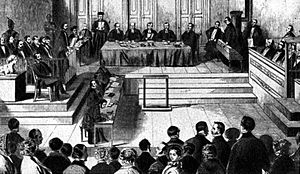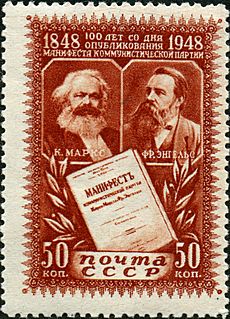The Communist Manifesto facts for kids

First edition in German
|
|
| Author | Karl Marx and Friedrich Engels |
|---|---|
| Translator | Samuel Moore |
| Country | United Kingdom |
| Language | German |
| Genre | Philosophy |
|
Publication date
|
21 February 1848 |
| Text | The Communist Manifesto at Wikisource |
The Communist Manifesto (German: Das Kommunistische Manifest) is a famous short book about politics. It was written by Karl Marx and Friedrich Engels. They wrote it for a group called the Communist League and it was first published in London in 1848.
This book was the first time Marx and Engels clearly explained their main ideas. They believed that "the history of all society is the history of class struggles." This means that history is all about different groups of people fighting for power. These groups, or social classes, are defined by how people are connected to the means of production (how things are made). The Manifesto came out during a time of big protests and changes across Europe in 1848. It is still one of the world's most important political writings.
Marx and Engels used a special way of thinking to look at how European society grew. They studied different ways societies produced things, like early communities, ancient times, feudalism (when lords owned land and peasants worked it), and capitalism (our current economic system). They noticed that a new powerful group always appeared at each stage.
The book explains how the ways things are made, the relationships between people in production, and the tools used all affect society. Marx and Engels said that capitalism involves the exploitation (unfair use) of the proletariat (the working class) by the bourgeoisie (the rich owners). They argued that capitalism constantly changes how things are made and how people relate to each other. They believed that capitalism's need for workers and new markets makes the world more alike everywhere.
The Manifesto suggests that capitalism stops people from reaching their full potential. Instead, it makes people feel disconnected and unhappy. However, it also predicts that capitalism will lead to its own downfall. It says that the working class will become stronger and unite. This will lead to a revolution and the start of communism. Communism is described as a society with no social classes, where everyone can develop freely.
Marx and Engels suggested some changes to make this happen. These included ending private property (like land ownership) and inheritance. They also proposed a progressive income tax (where richer people pay a higher percentage). Other ideas were taking over banks, transport, and communication, and making education free for everyone. The book famously ends with a call for workers around the world to unite. It says: "Workers of the world, unite! You have nothing to lose but your chains."
Contents
Understanding the Communist Manifesto
The Communist Manifesto has an introduction and four main parts. The introduction begins with a famous line: "A spectre is haunting Europe—the spectre of communism." This means that the idea of communism was spreading and making people in power nervous. The authors then say that communists should openly share their ideas, which is what the Manifesto does.
Bourgeoisie and Proletarians: The Class Struggle
The first part, "Bourgeois and Proletarians," talks about how history is a story of class struggles. Marx and Engels believed that in every society, a small group of powerful people has always taken advantage of a larger, less powerful group. In their time, under capitalism, they saw the industrial working class (the 'proletariat') fighting against the owners of factories and businesses (the 'bourgeoisie').
They argued that the bourgeoisie became the most powerful group by constantly changing how things were made. This replaced older systems like feudalism. The bourgeoisie made profits by using the workers' labour power (their ability to work). However, Marx and Engels believed that by doing this, the bourgeoisie was also creating its own downfall. They thought the working class would eventually realize their power and rise up in a revolution to overthrow the bourgeoisie.
The second part, "Proletarians and Communists," explains the role of communists. It says that communists are part of the working class but have a clearer understanding of the overall goals. They don't oppose other working-class groups. Instead, they aim to represent the common interests of all workers worldwide, no matter their country.
This section also lists some short-term goals. These include a tax system where richer people pay more, ending inherited wealth, stopping child labour, and providing free public education. They also suggested that the government should control transport, communication, and banks. They believed these changes would lead to a society with no social classes and no need for a government.
Different Kinds of Socialism
The third part, "Socialist and Communist Literature," explains how communism is different from other socialist ideas of the time. These other ideas included "Reactionary Socialism," "Conservative or Bourgeois Socialism," and "Critical-Utopian Socialism." Marx and Engels criticized all these other ideas. They felt these ideas only wanted small changes and didn't see the important role of the working class in bringing about a big revolution.
Communists and Other Parties
The last part of the Manifesto briefly talks about how communists should work with other political groups in different countries. It mentions countries like France, Switzerland, Poland, and Germany. It predicts that a revolution in Germany would soon lead to a world revolution. The section ends by calling for all workers around the world to unite and take action together.
How the Manifesto Was Written
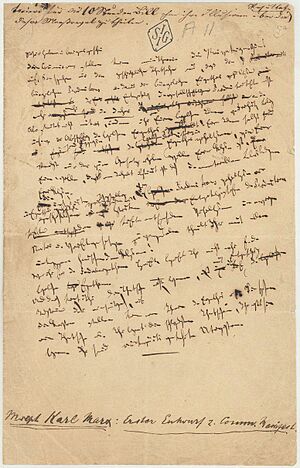
In 1847, Marx and Engels joined a group called the League of the Just. This group quickly liked their ideas about "critical communism." At their first meeting in June, the League asked Engels to write a statement of their beliefs. Engels wrote a draft called "Draft of a Communist Confession of Faith." Later, in October, Engels found that another member, Moses Hess, had written a manifesto that wasn't very good. Engels criticized it and was asked to write a new one. This became the draft Principles of Communism.
In November, before another meeting of the Communist League, Engels wrote to Marx. He said he wanted to write a "manifesto" instead of a question-and-answer style document, because it "must contain some history." Marx and Engels met in Belgium and then in London for the meeting. There was a lot of debate, but Marx convinced the others to agree to his plan. The League then asked Marx and Engels to write the Manifesto.
When Marx returned home, he took a long time to start writing. He was busy giving talks and writing articles. The Communist League eventually sent him a deadline, telling him to finish the book by February 1. This deadline made Marx work quickly to finish it.
The Manifesto was written in about 6 to 7 weeks. Even though Engels is named as a co-writer, Marx wrote the final version himself. Engels later said in 1883 that the main ideas in the Manifesto belonged "solely and exclusively to Marx." However, many historians believe Engels's earlier writings were very similar to the Manifesto's content. They think Marx and Engels shared ideas and worked together closely.
Publishing the Manifesto
First Editions and Quiet Years (1848–1872)
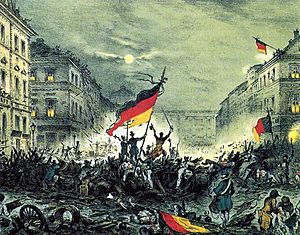
The Manifesto was first published in German in London in February 1848. It was a 23-page booklet with a dark-green cover. It was reprinted several times and also appeared in a German newspaper. Soon after, Marx was forced to leave Belgium. Copies of the Manifesto reached Paris and then Germany.
Even though the Manifesto said it would be published in many languages, the first printings were only in German. Polish and Danish translations came out soon after. In 1850, the Manifesto was published in English for the first time. This was in a magazine called The Red Republican. The translator was Helen Macfarlane. Her version started: "A frightful hobgoblin stalks throughout Europe. We are haunted by a ghost, the ghost of Communism." This English publication also revealed for the first time that Marx and Engels were the authors.
A French translation came out just before a workers' uprising in Paris was put down. The Manifesto's influence in the 1848 revolutions was mostly in Germany. There, the Communist League and its newspaper, edited by Marx, played a big role. But the newspaper was shut down, and Marx had to move to London for the rest of his life. In 1851, members of the Communist League were arrested and later sent to prison.
After the revolutions failed, the Manifesto was not widely known for many years, through the 1850s and 1860s. Only a few new editions were published during this time.
Growing Popularity (1872–1917)
In the early 1870s, the Manifesto and its authors became popular again. This happened for a few reasons. First, Marx became a leader in the International Workingmen's Association. Second, he became well-known for supporting the Paris Commune in 1871. Third, and perhaps most importantly, German political leaders were put on trial. During the trial, the Manifesto was read aloud as evidence. This meant it could now be legally published in Germany.
So, in 1872, Marx and Engels quickly released a new German edition. They wrote a new introduction, explaining that some parts of the book were now a bit old. This edition was also the first time the title was shortened to The Communist Manifesto. This version became the basis for all future editions. Between 1871 and 1873, the Manifesto was published in over nine editions in six languages. It was first published in the United States in 1871. However, by the mid-1870s, it was still only moderately well-known.
Over the next 40 years, as social-democratic parties grew across Europe, so did the publication of the Manifesto. Hundreds of editions came out in 30 languages. Marx and Engels wrote new introductions for later editions. After Marx died in 1883, Engels wrote introductions for five more editions. The 1888 English edition, translated by Samuel Moore and approved by Engels, became the standard English version.
The book was most popular in central Europe, from Russia to France. It had less impact in southern Europe and a moderate presence in the north. Outside Europe, Chinese and Japanese translations were published, as well as Spanish editions in Latin America. The first Chinese edition came out after the 1905 Russian Revolution. The popularity of the Manifesto in a country often showed how strong socialist movements were there.
Widespread Use (1917–Present)
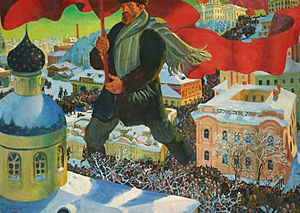
After the October Revolution in 1917, the Vladimir Lenin-led Bolsheviks took power in Russia. They founded the world's first socialist state, based on Marxist ideas. The Soviet Union became a one-party state. Unlike other large political parties, the Communist Party of the Soviet Union expected its members to know the classic works of Marx, Engels, and Lenin. Party leaders were also expected to base their decisions on these ideas. So, books like the Manifesto became required reading for party members.
Because of this, spreading Marx and Engels's works became very important. The Soviet Union had huge resources to do this. Their books were published on a very large scale and were cheap to buy in many languages around the world. This greatly increased the circulation of the Manifesto. For example, in 1932, American and British Communist Parties printed hundreds of thousands of copies of a cheap edition.
The book also started to be taught in universities. After World War II, this became even more common. For its 100th anniversary in 1948, not only Marxists and academics published it, but also general publishers. It was no longer just a Marxist document; it had become a classic political book.
It's estimated that 500 million copies have been sold, making it one of the best-selling books of all time. Even after the Soviet Union broke up in the 1990s, the Communist Manifesto is still widely available. Anyone with access to a good bookstore, library, or the internet can find it. For its 150th anniversary, there was a lot of attention from the media and universities. New editions were published, sometimes with introductions by famous academics.
The Manifesto's Lasting Impact
Many writers in recent times have talked about how the Communist Manifesto is still important today. In 2002, academic John Raines said: "In our day this Capitalist Revolution has reached the farthest corners of the earth. ... Read The Communist Manifesto, written more than one hundred and fifty years ago, and you will discover that Marx foresaw it all." In 2003, Chris Harman said that the book still explains today's world of wars, economic problems, hunger, and "overproduction." Alex Callinicos called it "a manifesto for the 21st century."
However, some critics have different views. Eduard Bernstein, a socialist who wanted reform, thought that the early Manifesto was too focused on violent revolution. He preferred Marx's later ideas, which seemed to suggest that socialism could be achieved peacefully through laws in democratic countries. Bernstein also argued that the large, unified working class described in the Manifesto didn't really exist. He noted that the middle class was growing, and the working class itself had many different groups. Marx himself later agreed that the middle class was not disappearing.
In 2013, The Communist Manifesto was added to UNESCO's Memory of the World Programme. This program recognizes important historical documents.
What Influenced the Manifesto
Marx and Engels were influenced by many ideas when writing the Manifesto. These included German philosophy, French socialism, and English and Scottish ideas about how economies work. The Manifesto also took ideas from literature. For example, some scholars believe that William Shakespeare's play Hamlet influenced Marx and Engels. They also think that the English poet John Milton had a big impact. Historians know that Marx loved Shakespeare. Milton's ideas about a republic and revolution also helped shape the Manifesto's message. The Manifesto also mentions the social criticism of Thomas Carlyle, another writer Engels had read.
Editions
- Karl Marx, Friedrich Engels (2004) [1848]. Manifesto of the Communist Party. Marxists Internet Archive. Retrieved on 14 March 2015.
See also
 In Spanish: Manifiesto del Partido Comunista para niños
In Spanish: Manifiesto del Partido Comunista para niños


